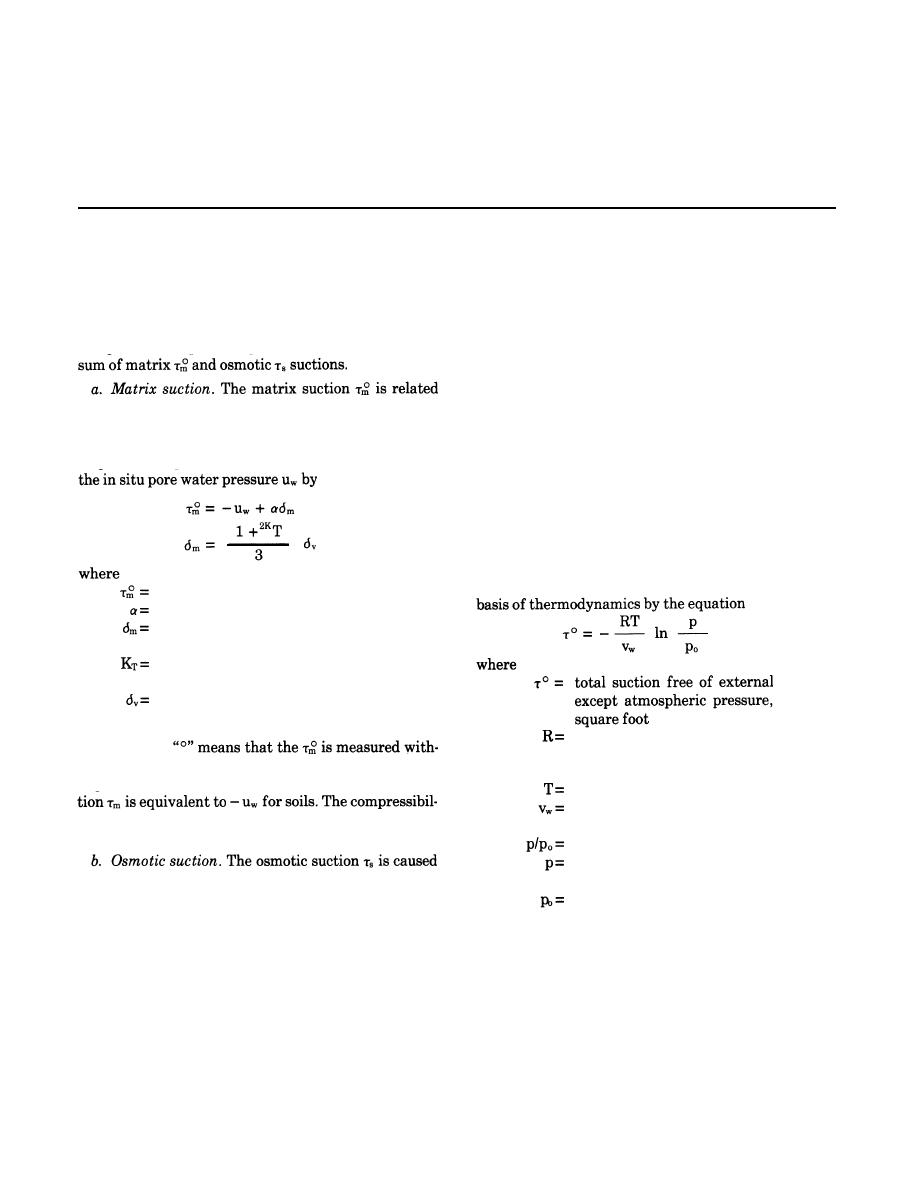
TM 5-818-7
APPENDIX B
CHARACTERIZATION OF SWELL BEHAVIOR FROM SOIL SUCTION
B-2. Methods of measurement
B-1. Introduction
Two methods are recommended for determining the
Soil suction is a quantity that can be used to character-
total soil suction: thermocouple psychrometer and fil-
ize the effect of moisture on volume, and it is a meas-
ter paper. The suction range of thermocouple psychro-
ure of the energy or stress that holds the soil water in
meters usually is from 1 to 80 tons per square foot
the pores or a measure of the pulling stress exerted on
while the range of filter paper is from 0.1 to more than
the pore water by the soil mass. The total soil suction
1,000 tons per square foot. Two to seven days are re-
is expressed as a positive quantity and is defined as the
quired to reach moisture equilibrium for thermocouple
psychrometer, while 7 days are required for filter
paper. The thermocouple psychrometer method is sim-
to the geometrical configuration of the soil and struc-
ple and can be more accurate than filter paper after
ture, capillary tension in the pore water, and water
the equipment has been calibrated and the operating
sorption forces of the clay particles. This suction is al-
procedure established. The principal disadvantage is
so pressure-dependent and assumed to be related to
that the suction range is much more limited than the
filter paper method, The filter paper method is techni-
(B-1)
cally less complicated than the thermocouple psy-
chrometer method; however, the weighing procedure
(B-2)
required for filter paper is critical and vulnerable to
large error.
a. Calibration. The total soil suction is given on the
matrix soil suction, tons per square foot
compressibility factor, dimensionless
total mean normal confining pressure,
(B-3)
tons per square foot
ratio of total horizontal to vertical stress
pressure
in situ
tons per
total vertical pressure, tons per square
foot
universal gas constant, 86.81 cubic cen-
The exponent
timetres-tons per square foot/mole-Kel-
out confining pressure except atmospheric pressure.
vin
Experimental results show that the in situ matrix suc-
absolute temperature, Kelvin
volume of a mole of liquid water, 18.02
ity factor is determined by the procedure in paragraph
cubic centimetres/mole
B-3d.
relative humidity
pressure of water vapor, tons per
by the concentration of soluble salts in the pore water,
square foot
and it is pressure-independent. The effect of the os-
pressure of saturated water vapor, tons
motic suction on swell is not well known, but an osmot-
per square foot
ic effect may be observed if the concentration of solu-
Equation (B-3) shows that the soil suction is related to
ble salts in the pore water differs from that of the ex-
the relative humidity in the soil. Both thermocouple
ternally available water. For example, swell may occur
psychrometer and filter paper techniques require cali-
in the specimen if the external water contains less
bration curves to evaluate the soil relative humidity
from which the soil suction may be calculated using
soluble salts than the pore water. The effect of the os-
motic suction on swell behavior is assumed small com-
equation (B-3). Calibration is usually performed with
pared with the effect of the matrix suction. The osmot-
salt solutions of various known molality (moles of salt
ic suction should not significantly affect heave if the
per 1,000 grams of water) that produce a given rela-
tive humidity. Table B-1 shows the modalities re-
salt concentration is not altered.
B-1



 Previous Page
Previous Page
